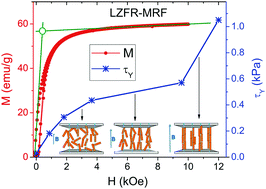Magnetorheological fluids containing rod-shaped lithium–zinc ferrite particles: the steady-state shear response†
Abstract
We report the magnetic field and particle-concentration dependent steady-state shear-responses of rod shaped Li–Zn ferrite particle based magnetorheological fluids (MRFs). Rod-shaped soft ferrimagnetic Li–Zn ferrite (Li0.4Zn0.2Fe2.4O4) particles were synthesized using the combustion synthesis method. MRFs of three different particle-concentrations (ϕ = 0.1, 0.2 and 0.4, in weight fraction) were prepared using silicone oil. Their yield strength and dynamic viscosity were studied at different applied magnetic fields (B). With an increase in B and ϕ, the yield strength (τY) of the MRFs increases. This behaviour is assigned to the formation of stronger columnar structures of the magnetically interacting particles which resist the flow (shear) of the MRF. For the MRF with ϕ = 0.4 and B = 1.2 T, we observed a maximum τY value of ∼1.25 kPa. Furthermore, we observed that, based on the on-state to off-state viscosity ratio (ηon/ηoff) at a particular operating B value, the optimum particle concentration required for energy- and cost-efficient operation of the MRFs can be chosen. The absence of a stabilizing-agent or de-agglomerating-coating, the low density, and the excellent oxidation- and corrosion-resistance of the soft ferrimagnetic rod-shaped Li–Zn ferrite particles make this MRF-system highly versatile and economical for many magneto-mechanical applications.



 Please wait while we load your content...
Please wait while we load your content...